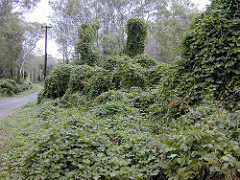Tips & Tricks for Common Pests – Glycine

Glycine blankets the roadsides of Ulupalakua and parts of Kula. Photo by Forest and Kim Starr
With all the rain last summer, many upcountry Maui homeowners spent the winter battling a twining green vine. Glycine, most commonly known from ʻUlupalakua and Kanaio, is the vine that blankets fences and rock walls and hangs from trees. It primarily grows in open sunny areas. When the rains come, a flush of seedlings follows.
Related to the common soybean, glycine (Neonotonia wightii) is a nutrient-rich nitrogen fixer. The Soil Conservation Service introduced this tropical vine to Hawai’i after a massive kikuyu grass dieback in the 1970s. Glycine was widely recommended for pasture improvement and forage. Grazing animals love it, but in their absence, the vine can take over.

Glycine seeds remain viable for years in the soil. Photo by Forest and Kim Starr.
Diana Crow is the Native Plant Project and Nursery Manager for ʻUlupalakua Ranch, a position that has necessitated she be adept at glycine control. Her advice for controlling the weed:
- Biological: Animals love glycine – a pet goat would be happy to help you.
- Mechanical: First, cut all the vines back from the tree or bush you are trying to save and loosen the vine along the trunk and branches to stop the vine from strangling the tree. Follow the vine down to the ground and pull or cut out the roots. If any root is left in the ground you will have to check for resprouts and cut it back until the reserves in the root are exhausted. If the plant has been there for a while, there will be a seedbank. Flushes of seedlings can be controlled by putting down boards, black plastic, or anything that blocks water and sunlight until seedlings die, usually within a month or two. Solarization of the seedbank may be possible in sunny areas. (Solarization is a method of reducing the seedbank by covering the soil with clear plastic until the sun heats it to a point that kills the seeds. Check for resources online.)
- Chemical: Apply herbicide directly to the cut trunk of a vine. Make sure to use a broad-spectrum herbicide, one intended for broadleaf plants that is effective on legumes. The College of Tropical Agriculture and Human Resources recommends a foliar spray of 2% triclopyr amine with a surfactant in the “Weeds of Pastures and Natural Areas.”
- Cultural: Glycine thrives with water; reducing irrigation or sprinklers may help, but not in the presence of seasonal rains. The seedpods will twist when ripe and dry, shooting seeds yards away. Glycine’s seed bank seems to last years, as Diana still has seedlings coming up from an area where a plant was removed 8 years ago. Her advice: DON’T LET IT SEED!
We recommend using an Integrated Pest Management approach to managing weed pests and the information provided here reflects that perspective.


